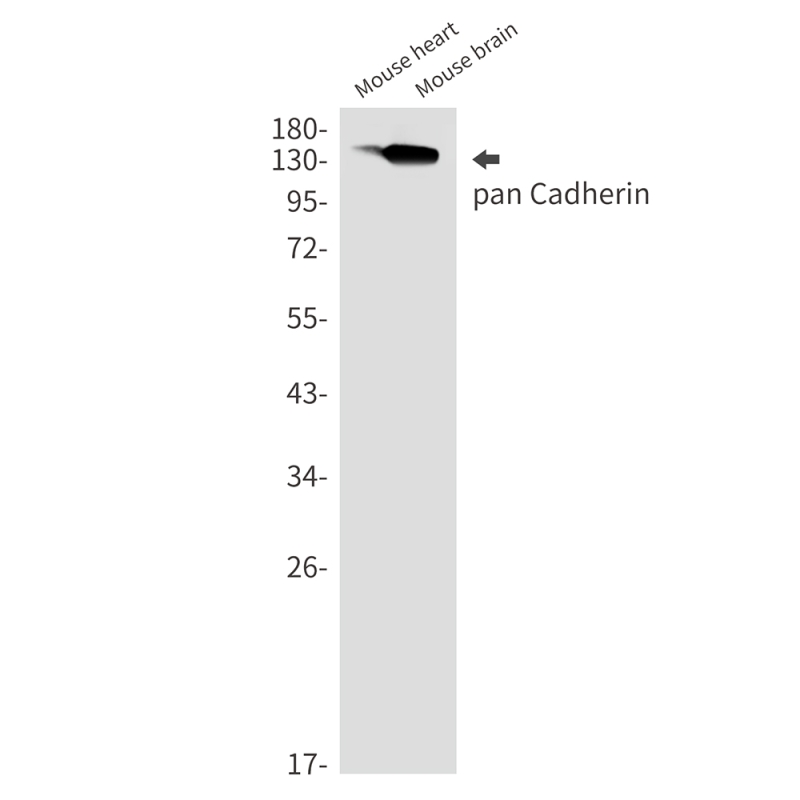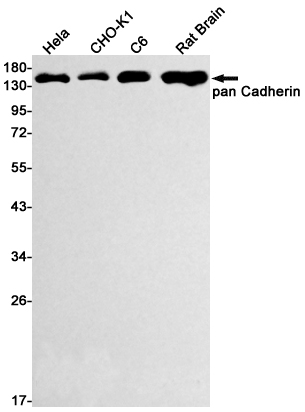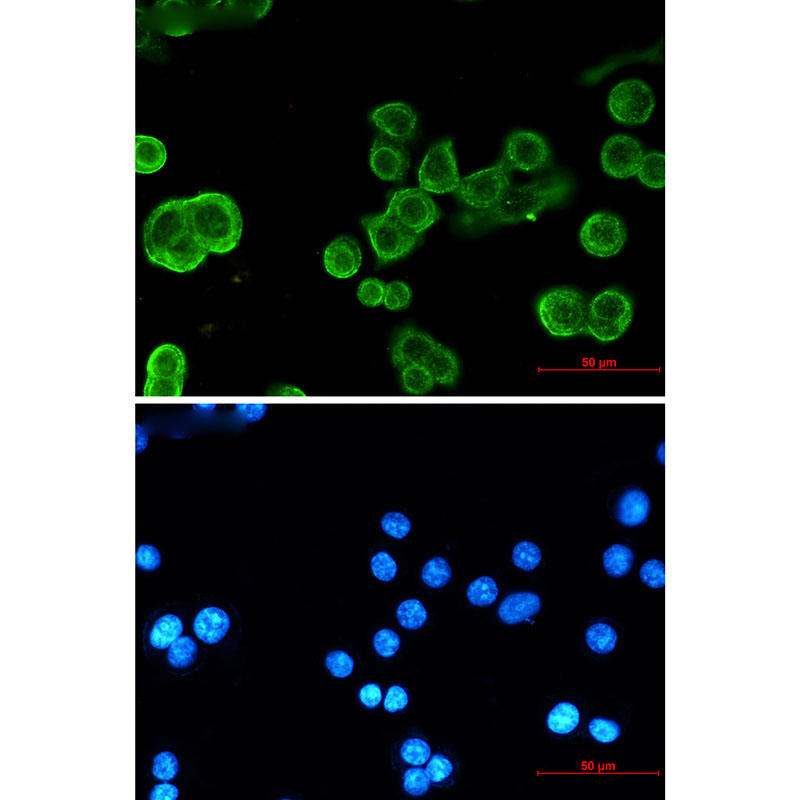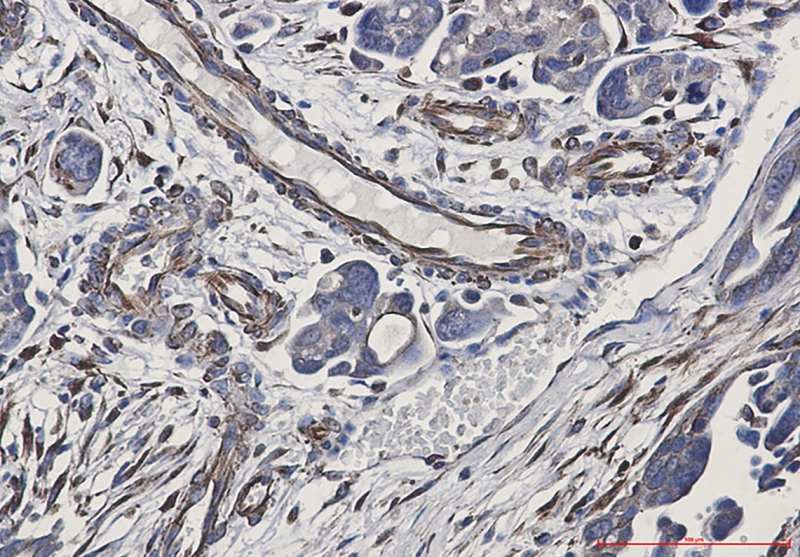



| WB | 1/500-1/1000 | Human,Mouse,Rat,Hamster |
| IF | 1/20 | Human,Mouse,Rat,Hamster |
| IHC | 1/50-1/100 | Human,Mouse,Rat,Hamster |
| ICC | 1/50-1/200 | Human,Mouse,Rat,Hamster |
| FCM | 咨询技术 | Human,Mouse,Rat,Hamster |
| Elisa | 咨询技术 | Human,Mouse,Rat,Hamster |
| Aliases | CDHP; CDHE; HJMD; PCAD; CDHN; P-cadherin; E-cadherin; N-cadherin; Cadherin-1; Cadherin-2; Cadherin-3 |
| Entrez GeneID | 999/1001/1000 |
| WB Predicted band size | Calculated MW: 97 kDa; Observed MW: 130-150 kDa |
| Host/Isotype | Rabbit IgG |
| Antibody Type | Primary antibody |
| Storage | Store at 4°C short term. Aliquot and store at -20°C long term. Avoid freeze/thaw cycles. |
| Species Reactivity | Human,Mouse,Rat,Hamster |
| Immunogen | A synthetic peptide of human pan Cadherin |
| Formulation | Purified antibody in TBS with 0.05% sodium azide,0.05%BSA and 50% glycerol. |
+ +
以下是3-4篇关于Cadherin抗体的参考文献及其简要摘要:
---
1. **文献名称**:*"A cadherin-based antibody validates the role of E-cadherin in cell-cell adhesion and cancer progression"*
**作者**:Shimoyama Y. et al. (1992)
**摘要**:该研究通过制备针对E-cadherin胞外域的单克隆抗体(如HECD-1克隆),验证了E-cadherin在上皮细胞间黏附中的作用,并证明抗体阻断实验可抑制癌细胞聚集,提示其在肿瘤转移中的潜在调控机制。
---
2. **文献名称**:*"Characterization of N-cadherin-specific antibodies for functional studies in neural development"*
**作者**:Daugherty R.L. et al. (2014)
**摘要**:作者系统评价了多种市售N-cadherin抗体(如13A9克隆)在小鼠脑组织中的特异性,结合免疫沉淀和免疫荧光技术,揭示了N-cadherin在神经元突触形成中的关键作用,并强调了抗体选择对实验结果可靠性的影响。
---
3. **文献名称**:*"Standardization of P-cadherin antibody testing in breast cancer diagnostics"*
**作者**:Rebecca S. et al. (2017)
**摘要**:研究比较了不同实验室中P-cadherin抗体(如NCL-P-cadherin克隆)的染色一致性,提出标准化操作流程以提高乳腺癌组织样本中P-cadherin表达检测的重复性,为临床病理学提供参考。
---
4. **文献名称**:*"Antibody-based detection of cadherin-11 in fibrosis and tumor microenvironment"*
**作者**:Dusek R.L. et al. (2006)
**摘要**:通过开发高特异性抗Cadherin-11的多克隆抗体,研究揭示了其在纤维化病变和肿瘤基质中的异常表达,提示其作为疾病生物标志物及治疗靶点的潜力。
---
这些文献涵盖了抗体开发、特异性验证及在疾病研究中的应用,可为Cadherin相关实验设计提供参考。
Cadherins are a family of calcium-dependent transmembrane glycoproteins critical for cell-cell adhesion, playing essential roles in tissue morphogenesis, integrity, and polarity. They mediate homophilic interactions (binding to the same cadherin subtype) through their extracellular domains, while their intracellular domains interact with catenins to link the actin cytoskeleton. Major subtypes include epithelial (E-cadherin), neural (N-cadherin), and placental (P-cadherin), each exhibiting tissue-specific expression patterns. Dysregulation of cadherins is implicated in cancer metastasis, cardiovascular diseases, and developmental disorders.
Cadherin antibodies are immunological tools designed to detect, quantify, or modulate cadherin proteins in research and diagnostics. These antibodies are generated using immunogens derived from conserved regions of cadherin extracellular or intracellular domains. They enable techniques like immunohistochemistry, Western blotting, flow cytometry, and immunofluorescence to study cadherin localization, expression levels, and functional interactions. Specific antibodies can distinguish between cadherin subtypes or post-translational modifications (e.g., cleavage products in cancer). Some therapeutic antibodies are being explored to target cadherin-mediated signaling in diseases. Validation parameters include species cross-reactivity, epitope specificity, and application compatibility. Challenges include addressing homology between cadherin family members and preserving calcium-dependent conformational epitopes during experimental procedures.
×